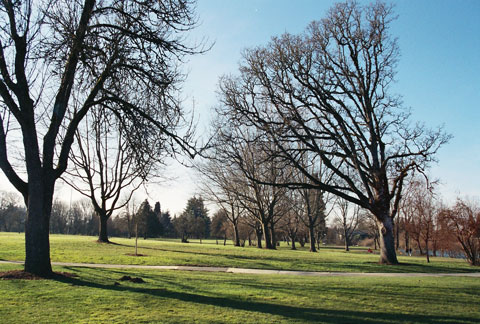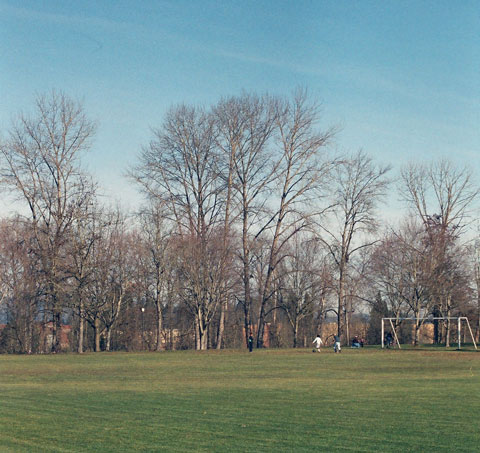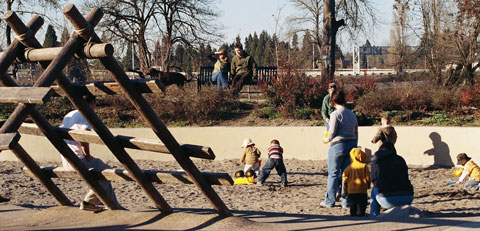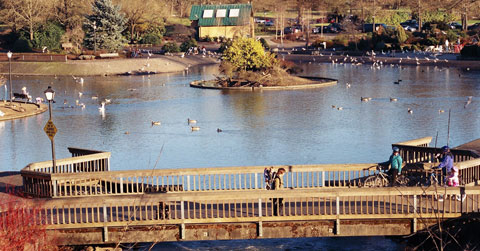A river runs through themThe Willamette River runs between some of Eugene's most historic parks. Each park has its own identity and value.
See the parks for yourselfBy Nat LevyAs the sun starts to come out, the people follow. Throughout the cold, dreary winters in Eugene, many people stay away from the parks, but once the grounds dry out, people emerge. The banks of the Willamette River, bordered on one side by the freeway, and four of Eugene's best parks on the other, becomes a hot spot in Eugene once the parks dry out. The main parks, Maurie Jacobs Park, The Owen Rose Garden, Skinner's Butte Park and Alton Barker Park each have their own character. "The legacy of these parks goes way back," said Phillip Richardson, a landscape artist with the City of Eugene's Parks and Open Spaces division. "I don't know everything, but I know that." Maurie Jacobs
Though the field is closed, the game goes onMaurie Jacobs Park is the starting point on this journey down the river. The citizens of Eugene recognized Jacobs for his desire to acquire and maintain land for public use. Along with his penchant for land management, Jacobs was a businessman, founding what is now known as M. Jacobs Furniture. Jacobs' passion for creating public parks remains visible long after his death in 1988. Kalapuya Indians once occupied Jacobs and other parks in Eugene. According to documents supplied by the city, construction workers found a number of Kalapuya artifacts in 1984 while constructing the bike path through the park. Thomas J. Connolly, a professional archaeologist, came in to investigate. He found that the artifacts did not carry enough significance to stop construction. The park's greatest draw is a massive open field on which people play soccer, ultimate Frisbee, softball or any other field sport. Currently that field features a giant sign protruding from the grass saying that the field is closed due to "re-turfing." The sign has stood since last May, but it hasn't stopped some people from enjoying the space. "We know it says not to play, but it's not like they are going to kick us off," said a soccer player by the name of Armando. A small playground borders the edge of the field. According to city documents, the playground was named Myra's playground for a 6-year-old girl killed in an auto accident in the early 1980s. Builders of the park moved the playground around several times, but it now resides underneath a group of trees. Families frequent the area because of the shade. One day in February the sun broke through the clouds, and the runners, bikers and families playing baseball and soccer arrived at the park. As the mid-fielder, Armando, said, "We're just trying to get out here before it rains on us." Owen Rose Garden-009.jpg)
One of the many beautiful roses in the gardenIn between Maurie Jacobs and the Owen Rose Garden is a short path that leads down to the water. On the sunny days, and a few cloudy days as well, the ducks and geese are fed handsomely. Sometimes they get a little too aggressive and start to surround those feeding them. A small child and his father received a little too much attention from a flock of geese. The Owen Rose Garden lies just beyond the small opening to the river. Though not nearly as picturesque during this time of year, the Rose Garden remains an inspiring place. In spring and summer the Garden possesses diverse groups of flowers and colors. The Garden, which is named for George Owen, the former owner of the land, features the world's oldest cherry tree. According to documents supplied by the city, "The Black Tartarian Cherry Tree is believed to be planted in 1847; just one year after Eugene Skinner filed the plat for the village he named Eugene City." Skinner's Butte
At the playground on a sunny dayContinue to travel east. Walk under the Washington/Jefferson Bridge, and the noise of excited children becomes clearer. This is Skinner's Butte Park, the area most frequented by kids. The park features the largest play area of the four parks, including a 30-foot slide. A 5-year-old boy named Danny, who had never been on the slide before, said, "That thing is huge. It's too big." After some gentle cajoling from his mother, the boy finally conquered the slide. He sprinted back to his mother and yelled, "I'm going again!" Before the arrival of Skinner, in 1846, the Kalapuya Indians used the Butte as a lookout. Skinner built the first house in Eugene on the eastern edge of the park. The log cabin, which was replicated for public display in 1970, serves as a historical exhibit for park visitors. Several explanatory signs border the cabin. They describe the Applegate Trial, which went through the park and provided explorers with a path through the Willamette Valley. Numerous people admired the cabin that day. After Danny's mother told him that the cabin was the first made in Eugene, he said, "No its not," Danny responded. "You're older than this place, mommy." Danny's mother read the sign indicating the cabin was a replica. She blushed and told her son that he was correct. Skinner's Butte Park hosts several events in the community. The annual Butte-to-Butte 10k run finishes in the park every year. Hundreds of people gather to cheer on the finishers, and the sponsors of the run set up elaborate displays at the finish line. They supply runners with special services such as complimentary massages. Alton Baker
The ducks and people are out and aboutAlton Baker Park is the bookend of this journey down the river. Officials have been trying to add to the park, which is already the largest at 329 acres, for years. According to city officials "Lavish plans have been made in the past for this park, some of which at one time included such amenities as a swimming beach, amusement park, restaurants, cultural center, Japanese Gardens, square dance facilities, soccer fields, a play land with a small zoo, a children's theater, theme playground, game booths, beer garden, pony rides, an aviary, and botanical gardens, among other features." None of these plans actually worked out. Alton Baker is a great place to find people, young and old, sun-bathing, swimming in the shallow river, or just running around. The park serves as a starting point for rafters and kayakers, who want to float down the river to Maurie Jacobs Park and beyond. Two small, man-made ponds break up the landmass a bit. A large population of ducks and geese inhabit these ponds. Often families come to these ponds to feed the birds, but sometimes the birds become unruly and start battling for scraps of food. The formation of Alton Baker Park proved to be the most complicated of the four parks. It all began in 1884 when the City of Eugene made two purchases of acreage near what is now the Ferry Street Bridge. The City continued to acquire and transfer land from the county to centralize the authority over the location. The park is named for Alton F. Baker, a recognized figure in the newspaper industry in the city of Eugene. Baker merged the Eugene Register with the Eugene Guard to form The Register-Guard in 1930. Baker shared Jacobs' desire to provide the public with open parks. Unfortunately he did not get to see his dream fulfilled. He died Oct. 27, 1967, of a heart attack in Yakima, Wash. All of these parks have historical value. They also provide the citizens with outdoor entertainment. The City of Eugene proclaims this town to be the World's Greatest City of Arts and the Outdoors. These four parks attempt to embody this slogan. |
